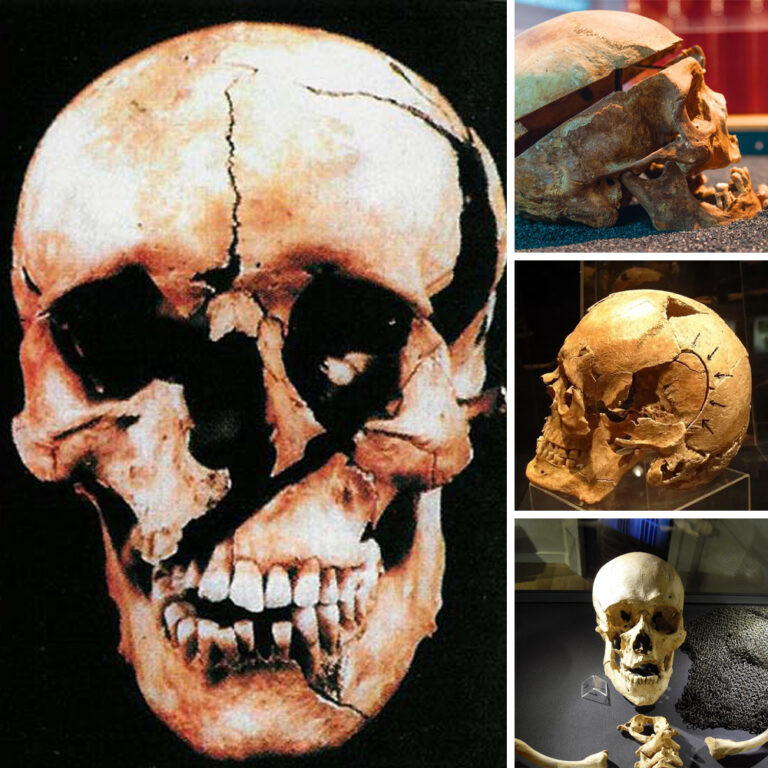In recent years, archaeologists have made a profoundly chilling discovery near the infamous battlefield of Towton—a mass grave filled with the skeletal remains of those who perished in the bloodiest battle of the Wars of the Roses. As researchers painstakingly excavated and analyzed these bones, a vivid story of brutality and resilience emerged, offering both a glimpse into the harrowing events of that fateful day and an opportunity to reflect on the human cost of war.
Bones as Silent Witnesses to History
The skeletal remains unearthed near Towton are more than just relics of the past; they are silent witnesses to a pivotal and devastating moment in history. The condition of these bones speaks volumes about the sheer intensity of the combat that unfolded on that snowy field in 1461. Each fracture, cut, and break tells a story—one of courage, desperation, and, ultimately, mortality.

The Weapons of War
The remains provide undeniable evidence of the devastating weaponry wielded during the battle. Skull fractures reveal the crushing force of war hammers and maces, while severed limbs and shattered bones testify to the ruthless efficiency of swords and poleaxes. Every injury paints a graphic picture of the chaos and carnage that engulfed the battlefield. These injuries speak not only of the violence but also of the warriors’ determination to fight for their cause, no matter the personal cost.
Lives Lived Before the Battle
Beyond the injuries sustained in combat, the bones unearthed at Towton offer valuable insights into the lives of the individuals who fought there. Forensic analysis allows researchers to estimate the ages and genders of the fallen, and in some cases, identify familial connections among them. These findings suggest that many who fought and died were young men, some still in their teens, with the possibility that brothers or fathers and sons fought side by side. Evidence of preexisting illnesses and signs of malnutrition hint at the struggles these individuals faced long before they stepped onto the battlefield, highlighting the harsh realities of life in medieval England.
A Grave That Speaks Volumes
The mass grave itself is a sobering testament to the scale of the slaughter at Towton. The haphazard arrangement of the skeletons indicates the urgency with which the dead were buried, likely to prevent the spread of disease. This somber resting place forces us to confront the human cost of conflict—each skeleton a life cut short, a family left to grieve, and a community forever changed. The sheer number of remains serves as a stark reminder of the devastating consequences of political strife and unchecked ambition.
The Human Cost of Conflict
The discovery of this mass grave compels us to reflect on the true price of war. Each set of remains represents not only an individual but also a web of relationships and connections that were irrevocably disrupted by the violence. As we study these bones, we are reminded that the consequences of conflict extend far beyond the battlefield, leaving scars on families and communities that can take generations to heal. The Battle of Towton, with its staggering loss of life, underscores the futility of violence as a means to resolve differences.
Honoring the Fallen Through Science
By carefully excavating and analyzing these remains, archaeologists and historians honor the memory of those who fought and died at Towton. Their work ensures that these individuals are not forgotten, transforming their silent testimony into a rich narrative of courage, struggle, and sacrifice. Through these efforts, we gain a deeper understanding of the past and, hopefully, draw lessons that can guide us toward a more peaceful future.
Lessons Written in Bone
The study of Towton’s mass grave offers more than just historical insights; it serves as a moral reminder. The violence and suffering endured by those who fought in the battle highlight the destructive nature of human conflict. Their bones, preserved through centuries, provide a unique opportunity for us to learn from history and consider the consequences of our actions. By examining their stories, we are reminded of the importance of striving for understanding, dialogue, and peaceful resolutions to disputes.
A Window Into England’s Violent Past
The Battle of Towton is a stark chapter in England’s history, marked by political intrigue, unrelenting brutality, and the harsh conditions of medieval warfare. The skeletons unearthed near the battlefield provide an unparalleled glimpse into this violent past, allowing us to piece together the human experiences behind the historical record. They connect us to a time when loyalty to a cause could mean the ultimate sacrifice and when lives were irrevocably shaped by the tides of war.
Looking to the Future
As we contemplate the stories told by these skeletal remains, we are reminded of the sacrifices made by those who came before us. The lives lost at Towton, though distant in time, resonate with us today as we grapple with the ongoing challenges of conflict and division. Their silent testimony encourages us to strive for a world where such tragedies remain confined to history books and where future generations can learn from the mistakes of the past.
The haunting discovery at Towton is not merely a relic of the past; it is a poignant reminder of the resilience of the human spirit and the enduring importance of peace. By preserving and studying these remains, we not only honor the fallen but also ensure that their sacrifices serve as a beacon of hope for a better tomorrow.





